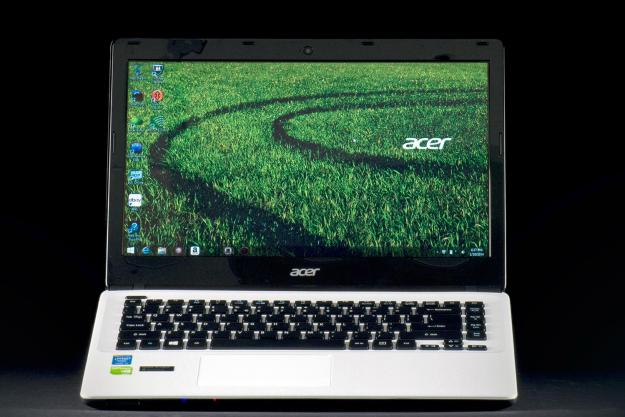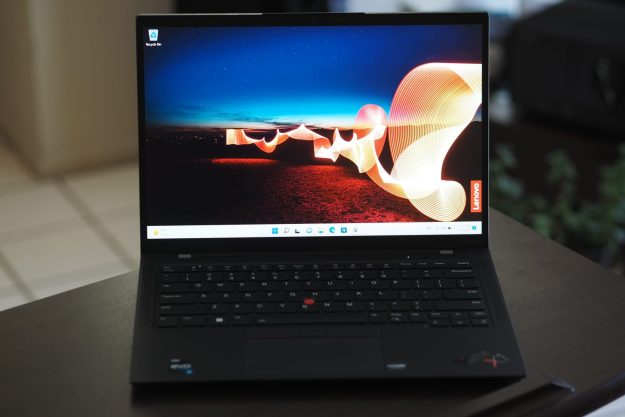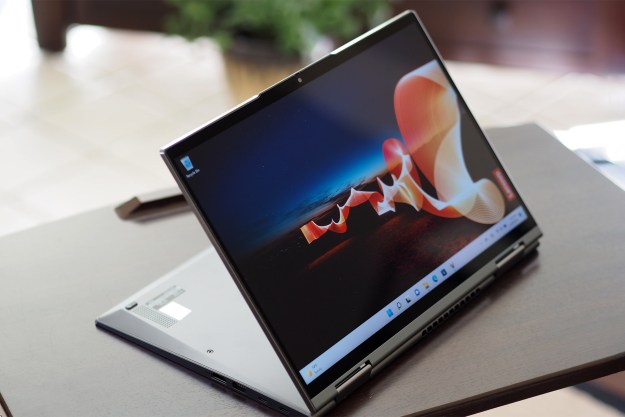
“The Aspire E1 may be inexpensive, but Acer sacrificed a lot to cram powerful hardware into a laptop that sells below $600.”
- Attractive and well-built for the price
- Strong CPU performance
- Decent speakers
- Poor 1366x768 display
- Short battery life
- Nvidia GPU isn’t a quick as hoped
Laptop manufacturers have struggled for years with the notebook’s falling average price. Despite the emergence of the Ultrabook, which was specifically designed to tempt users into spending more on their next notebook PC, the average buyer now spends less than $550 on a new laptop.
$550 will not buy an Ultrabook, a convertible, or a 2-on-1, and the Acer Aspire E1-472G is none of these. Instead, it harkens back to when more standard designs were the norm, and Acer attempts to make this notebook appealing on the strength of its core components as opposed to decking it out with an eye-catching stand or chassis.
This 14-inch system comes with a Core i5-4200U processor, 8GB of RAM, a 500GB hard drive and a 1,366 x 768 display, all of which are specs that we’d expect to see at the Aspire E1’s $599 asking price. There is a wild card thrown into the mix however, in the form of Nvidia’s GeForce GT 820M discrete GPU, an unusual addition for an inexpensive laptop.
Aside from the GPU, none of the specs make the Aspire E1 stand out, though the component roster here looks robust as a whole given the system’s low price. So is this 14-incher a solid value wrapped in a basic-looking shell, or is it merely an inexpensive also-ran?
Time warp
With the constant stream of high-end review units we get, we get a bit spoiled by the thin frames and advanced designs that many modern notebook PCs offer. Acer’s Aspire E1 feels, by contrast, like a laptop released several years back. The system is a full inch thick, while most laptops we review these days come in well under that mark.
Bulk aside though, as budget systems go, the Aspire E1 is impressive. Yes, the chassis is plastic and the slick, glossy materials are a bit cheap, but there’s almost no flex and the thick body feels durable.

Though it’s far from luxurious, the Aspire E1 doesn’t suffer from the offensively cheap build quality we’ve seen with some competitors.
We’re fans of the E1’s white exterior, which is decorated by a pattern of small, gray dots. This adds some visual flair that’s largely absent, but strongly needed on budget PCs, and we like the fact that the Acer Aspire E1-472G sports some flash without resorting to tacky chrome or gaudy colors. Though the Aspire E1 isn’t exactly professional-looking, it won’t look out entirely of place in a conference room either.
Connectivity includes three USB (one 3.0, two 2.0), HDMI, VGA, a combo headphone/microphone jack, Ethernet and a memory card reader. The Wi-Fi card supports 802.11 b/g/n but not the latest 802.11ac Wi-Fi standard. This is a decent array of ports, but we wish that all three USB connectors supported 3.0. We also dislike the fact all the ports are near the front of the system, which means that connecting wired devices to them will create a lot of desktop clutter in no time.
Conventional keys
Using this Acer to type out more than a few hundred words is like eating fast food; it does the job, but that’s about it. Touch typists will notice the Aspire E1’s lack of tactile feel and vague key travel, but most people will appreciate the spacious layout and decide that the keyboard works fine. Our review unit lacked backlighting, and it’s not available as an option, which could make low light use a bit of a pain.
The touchpad, which measures about 4 inches wide and 2 inches tall, is absolutely average. The surface is large enough, and multi-touch gestures work as well as they can in Windows 8. We appreciated the textured touchpad surface, which distinguishes it from the smooth plastic surrounding it, but we found the integrated left and right mouse buttons a chore to use because of vague feel when pressed. This resulted in occasional “clicks,” which, while they felt like they should perform an action, went unnoticed by the system.
Cheap laptop, cheap display
The 1,366 x 768 glossy panel on the Aspire E1 is a reminder that the bad old days of laptop display quality aren’t entirely over. Though the relatively low resolution is noticeable at a glance, the real problem is contrast. We measured a maximum ratio of only 80:1. Very poor black levels are to blame, and dark images look hazy even with display brightness turned down.
The Acer Aspire E1 may have some of the latest hardware from Intel and Nvidia, but it remains a laptop that’s rooted in the past.
Subjectively, the display’s poor quality is immediately and continually noticeable. Content looks flat and lifeless, and dark scenes suffer from a loss of detail as the panel struggles to reproduce deep tones. Viewing angles are extremely poor too, so performance worsens if the screen is tilted just a few degrees beyond a perfection position.
On the bright side, the speakers are acceptable. Maximum volume is sufficient for use in a small room, and quality is tolerable. There’s little muddiness in the mid-range, and only modest distortion. External headphones or speakers would still provide an improvement, but the built-in audio will suffice if there’s no other option for you.
Fast, slow, fast
Our Acer Aspire E1 review unit shipped with an Intel Core i5-4200U processor, which generated acceptable performance, reaching 38.81 GOPS in SiSoft Sandra’s Processor Arithmetic benchmark and 6,964 MIPS in the 7-Zip compression benchmark. These scores are right in line with other systems we’ve reviewed that included the same processor, like the Acer Aspire R7, which scored 6,590, and the HP ElitePad 820, which scored 7,062.
PCMark 8’s storage benchmark returned a disappointing score of 1,911. Only the Lenovo Flex 14, which scored 1,892, has performed worse. This is the downside to the 500GB mechanical hard drive which, though spacious, doesn’t offer the responsiveness or transfer speed of a SSD.
We gave the Nvidia GT 820M discrete graphics solution a chance to stretch its legs in 3DMark, and were surprised to see it turn in unimpressive scores. The Cloud Gate test reported a result of 4,105, while Fire Strike came back with a total of 775. Intel’s HD 4600 GPU can manage scores in the low 600s in Fire Strike, as it did when we reviewed the Dell XPS 13, Toshiba Kirabook and Lenovo X1 Carbon. We expected Nvidia’s hardware to enjoy a larger margin of victory.
The Acer Aspire E1 had no trouble handling League of Legends at its native resolution. The game ran at an average of 92 frames per second, with a minimum of 69 and maximum of 117 when set to medium detail. Bumping up to very high detail reduced performance to an average of 55 FPS, with a maximum of 61 and minimum of 42. These numbers are solid, but the benefit of the GT 820M remains less than obvious, as a system powered by Intel HD 4600 can run League of Legends almost as well.
Homebody
At one inch thick and weighing about 4.5 pounds, the Aspire E1 isn’t the best pick for travelers, but it’s portable enough to warrant consideration. The 14-inch screen translates to a relatively small chassis that will slip into most backpacks and messenger bags with ease. The power brick is also reasonably sized, though it’s nowhere near as small as those found alongside most Ultrabooks.
The brick tied to our review unit is Nvidia’s GT 820M.
Our wattmeter indicated that the Aspire E1 consumes power moderately in most situations. The system drew 10 watts of power at idle with the display at maximum brightness, and 22 watts at full processor load. These results are right in line with Ultrabooks. When we kicked the GT 820M into action with a game however, power consumption shot up to 48 watts. Most systems with Intel integrated graphics consume between 25 and 30 watts.
Cool, but not always quiet
In most situations, the Acer Aspire E1’s cooling system is both effective and calm. We measured a maximum external temperature of 87.9 degrees Fahrenheit at idle, and this figure did not budge when we stressed the processor. The fan is barely audible at idle, and hovers between 41 and 42 decibels during processor-centric tasks.

Gaming increased both heat and fan noise, however. Temperatures reached a high of 99.8 degrees, and the fan generated noise that reached 46.2dB. That’s a fairly high volume for a small, mainstream notebook. The Lenovo Flex 14 reached only 42.4dB, and the Acer TravelMate P645 produced 44.3 dB.
Conclusion
The Acer Aspire E1 may have some of the latest hardware from Intel and Nvidia, but it remains a laptop that’s rooted in the past. A lackluster display, poor battery life and a thick, bulky chassis make the E1 feel as if it was designed a few years ago. In today’s era of sleek Ultrabooks, it feels positively archaic.
We might be able to tolerate the Aspire E1’s shortcomings if it was affordable, but our review unit’s $599 MSRP seems a lot to ask. For instance, ASUS offers the 15.6 inch X550LB for $659, which wields the same CPU as the Acer, a larger 750GB hard drive, along with a faster GT 740M graphics chip for not much more.
Nvidia’s GT 820M GPU is the brick tied to our review unit. While quicker than Intel’s graphics chip, the difference between the two isn’t exactly night and day, and it’s still not sufficient for serious gaming.
This puts the Aspire E1-472G is an uncomfortable position, as the system isn’t inexpensive enough to be considered a bargain, but also not quick enough to be a regarded as a powerhouse. While a few buyers may be attracted to this laptop’s combination of small size and moderate performance ability, we think most will find it to be an unsatisfactory compromise.
Highs
- Attractive and well-built for the price
- Strong CPU performance
- Decent speakers
Lows
- Poor 1,366 x 768 display
- Short battery life
- Nvidia GPU isn’t a quick as hoped
Editors' Recommendations
- Acer gets serious about 14-inch gaming laptops
- Best 2-in-1 laptop deals: Turn your laptop into a tablet for $315
- 7 best 2-in-1 laptops in 2024: tested and reviewed
- Acer’s new gaming laptop bring Nvidia RTX 40-series GPUs under $1,000
- This Windows laptop costs under $1,000 and handily beats the MacBook Air









